Feature Articles - Germany's Use of Chemical Warfare in World War I
The purpose of this article is to discuss the role of the German chemical warfare program in World War I.
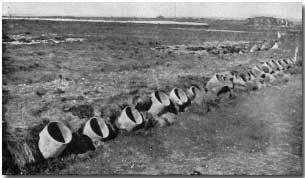 The
paper will focus primarily on the German offensive use of chemical agents
(gas) and will discuss the defensive measures of the Allies. The paper
will define chemical warfare and explain its early use. It will
discuss Germany's use of various chemicals and their delivery systems.
It will also mention the number of casualties that Germany caused by using
gas and the psychological effect it had on the Allied soldiers. The
paper will examine how gas effected several battles. In conclusion, I
will discuss the overall effects that gas had on World War I.
The
paper will focus primarily on the German offensive use of chemical agents
(gas) and will discuss the defensive measures of the Allies. The paper
will define chemical warfare and explain its early use. It will
discuss Germany's use of various chemicals and their delivery systems.
It will also mention the number of casualties that Germany caused by using
gas and the psychological effect it had on the Allied soldiers. The
paper will examine how gas effected several battles. In conclusion, I
will discuss the overall effects that gas had on World War I.
A current definition of chemical warfare is the "aspects of military operations involving the employment of lethal and incapacitating chemical munitions or agents." However, on the eve of World War I, no definition of chemical warfare existed. Although reports of the employment of poisonous or suffocating gases date back to Spartan forces attacking an Athenian city in the fifth century B.C., the use of chemical agents in warfare before the 20th century were relatively isolated.
The Hague Conventions
At the end of the 19th century, a number of men foresaw the devastation that chemical agents could cause in a European war. The Hague Convention of 1899 discussed the issue of using chemicals as weapons. The Contracting Powers agreed not to use projectiles whose sole purpose was the diffusion of asphyxiating or deleterious gases. Delegates from all of the attending countries except the United States signed the resolution.
The Hague II Convention reaffirmed the provisions on chemical weapons usage and widened the restraints by prohibiting the use of poison or poisoned weapons. Hague II included a clause for the avoidance of projectiles, weapons, and materials that could cause unnecessary suffering. Hague II, like Hague I, had no provision for enforcement. Prior to World War I, all of the future belligerents except Italy, the US, and Turkey were signatories of Hague II. Both Hague I and Hague II had good intentions: to stop the creation of new and possibly more awful weapons, yet the wording of the conventions was obscure and interpretations differed considerably between countries.
First Uses
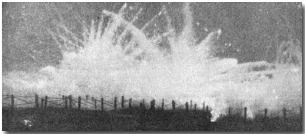 The German attack through Belgium
and into France in August 1914 quickly stalled into a static trench war.
Germany, looking to break the deadlock, decided that a possible solution was
the use of poison gas. However, Germany did not want to be the first
to break The Hague Conventions, so they sought an indication that the Allies
were using gas. In August 1914, France used 26-mm gas grenades during
a battle. Newspaper reports of France developing a liquid explosive,
turpinite, which gave off lethal fumes, caused Germany additional concern
over France's development and deployment of chemical weapons.
The German attack through Belgium
and into France in August 1914 quickly stalled into a static trench war.
Germany, looking to break the deadlock, decided that a possible solution was
the use of poison gas. However, Germany did not want to be the first
to break The Hague Conventions, so they sought an indication that the Allies
were using gas. In August 1914, France used 26-mm gas grenades during
a battle. Newspaper reports of France developing a liquid explosive,
turpinite, which gave off lethal fumes, caused Germany additional concern
over France's development and deployment of chemical weapons.
After a French bombardment that left soldiers dead due to asphyxiation, Germany blamed the deaths on turpinite. Germany's capture of a French document, dated 21 February 1915, describing chloroacetone cartridges and grenades and explaining their use, gave Germany more data to back up its claim that France was using chemical weapons. These and other incidents increased Germany's belief that France was using gas. Moreover, the German High Command felt that Germany was now free to used poison gas.
When Germany launched its chlorine attack at Ypres on 22 April 1915, it caught the world by surprise. It aroused world public opinion, which blamed Germany for breaching The Hague Conventions. Germany justified its actions. They stated that The Hague Conventions only discussed projectiles whose sole purpose was the diffusion of asphyxiating or deleterious gases and did not cover gases released by cylinders. The Germans also stated that France broke the conventions first.
Throughout the rest of the war, Germany used chemical warfare agents in many of its' military operations. Chemical warfare agents are chemical substances designed to kill, seriously injure, or incapacitate humans and animals. Chemical agents can also deny or hinder the use of areas, facilities, and materials.
Types of Chemicals
Chemical agents are grouped into categories based on their physiological effects. Lachrymators are primarily designed to affect the eyes, but also cause respiratory problems when soldiers are exposed to a large quantity of the chemical. Asphyxiators cause fluid to enter the lungs and prevent oxygen from reaching the blood. Toxic gases pass through the lungs and into the blood and prevent the circulation and release of oxygen in the body. Sternutators caused respiratory irritation, sneezing, nausea, and vomiting. Blister agents initially cause pain in the eyes, throats, and lungs, but later cause blisters on exposed skin. Germany used various chemical agents during the war, depending on the desired effect they wished to inflict on the Allies.
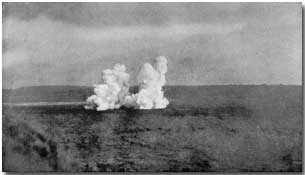 The
primary gases used in World War I were chlorine, phosgene, a mix of chlorine
and phosgene, and mustard. Chlorine is an asphyxiating gas that causes
acute bronchitis with gradual suffocation and, "those who initially survived
a considerable dose generally died from pneumonia." Phosgene, another
asphyxiating gas, was deadlier than chlorine because it incapacitated a
solder in less than one-fourth of the time of chlorine (41 seconds vs. 240
seconds) and it required a much lower concentration to cause death. A
combination of chlorine and phosgene also caused severe injuries, depending
on how much of the gas a soldier breathed. People seldom died when the
asphyxiating gas passed over them if they masked quickly enough and those
who breathed in small amounts of the gas usually recovered quickly.
The
primary gases used in World War I were chlorine, phosgene, a mix of chlorine
and phosgene, and mustard. Chlorine is an asphyxiating gas that causes
acute bronchitis with gradual suffocation and, "those who initially survived
a considerable dose generally died from pneumonia." Phosgene, another
asphyxiating gas, was deadlier than chlorine because it incapacitated a
solder in less than one-fourth of the time of chlorine (41 seconds vs. 240
seconds) and it required a much lower concentration to cause death. A
combination of chlorine and phosgene also caused severe injuries, depending
on how much of the gas a soldier breathed. People seldom died when the
asphyxiating gas passed over them if they masked quickly enough and those
who breathed in small amounts of the gas usually recovered quickly.
However, those that were badly gassed soon suffered severe inflammation of the lungs. The critical stage for these men usually occurred within three to four hours after initially being gassed. At this point, either the soldier would recover after sleeping, or his health would deteriorate further with death occurring within the next twenty-four hours. Mustard gas produces a large amount of casualties that require extensive medical treatment. Initially some soldiers did not realize that they had been gassed with mustard because the effects were not apparent for up to twelve hours after exposure. An unidentified Allied nurse stated:
"I wish those people who write so glibly about this being a holy war and the orators who talk so much about going on no matter how long the war lasts and what it may mean, could see a case - to say nothing of ten cases - of mustard gas in its early stages - could see the poor things burnt and blistered all over with great mustard-coloured suppurating blisters, with blind eyes . . .all sticky and stuck together, always fighting for breath, with voices a mere whisper, saying that their throats are closing and they know they will choke."
Due to the devastating effects of mustard, it was known as the "King of the Gases".
Germany held the initiative concerning chemical warfare from 1915 to 1918 in almost all areas of gas warfare. Their civilian industrial base for making chemicals was already a vast institution at the start of the war. The Germans simply needed to test the effectiveness of various chemicals (and chemical combinations) and match them with a delivery system. They maintained the initiative through the introduction of new agents, improved delivery systems, and new tactics.
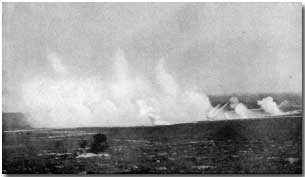 Although
Germany held the initiative, their chemists had to work hard to stay ahead
of the Allied chemists. One of the problems faced was that chemists
were not accustomed to the operational tempo that they had to work in.
They were used to a traditional way of systematic work; that of beginning
with theories, progressing slowly with the exchange of information, testing
products thoroughly, and then carefully producing them. However,
chemists soon found themselves conducting hurried testing on chemicals that
they knew little about. Security often left some scientists working in
a void that, with only a little help from the other chemists, could have
been solved. One of the many problems was the difficulty in finding
chemists to work on chemical agent production.
Although
Germany held the initiative, their chemists had to work hard to stay ahead
of the Allied chemists. One of the problems faced was that chemists
were not accustomed to the operational tempo that they had to work in.
They were used to a traditional way of systematic work; that of beginning
with theories, progressing slowly with the exchange of information, testing
products thoroughly, and then carefully producing them. However,
chemists soon found themselves conducting hurried testing on chemicals that
they knew little about. Security often left some scientists working in
a void that, with only a little help from the other chemists, could have
been solved. One of the many problems was the difficulty in finding
chemists to work on chemical agent production.
Academic chemists, used to working on their own, did not work well with technologists. The chemists were also unfamiliar with the military and its' rigid procedures. By the end of the war, Germany employed only 2,000 chemists. Less than ten percent of them had a university degree. The rest were chemistry students, laboratory technicians, and men from the medical, engineering, or ordnance branches of the armed services.
Until the end of the war, the German chemists generally remained well ahead of their Allied counterparts in the development of chemical agents and delivery systems. After Germany used phosgene, it took the Allies six months to employ it. The lag between the German and the Allied use of mustard gas was a year. However, while Germany remained ahead of the Allies in offensive chemical measures, they were not able to match the Allied defensive means against poison gases.
Delivery Methods
The main methods to deliver chemical agents were by cylinders and artillery. Gas delivery by cylinders was the most common early in the war because they were refillable and Germany lacked large-scale gas-shell production capabilities. Once the German ordnance department created artillery shells that could be filled with chemical agents and maintain a relatively stable flight path, they abandoned their unpredictable cylinder-based attacks.
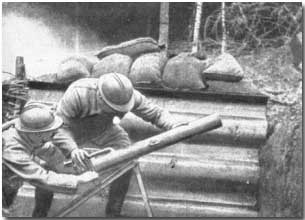 Cylinders
released gas clouds that would "float" towards the enemy. The
emplacement of cylinders was a time consuming project that usually took
several days of intense labour. Men transported the 100-pound
cylinders from drop-off points through the maze of trenches to the front
lines. Soldiers then dug in the cylinders to prevent them from being
destroyed by enemy artillery fire. The movement and placement of these
cylinders (sometimes numbering up to 12,000 for a single operation) in front
of the friendly trenches was usually accomplished during hours of limited
visibility so that the enemy would not detect it and be alerted to an
imminent chemical attack. If the enemy detected the placement of
cylinders, artillery often targeted these areas with harassing fire.
This harassing fire served two purposes; to slow down and hopefully halt the
placement of the cylinders, and to cause damage to the cylinders themselves,
thus exposing the enemy troops to its own chemical agents.
Cylinders
released gas clouds that would "float" towards the enemy. The
emplacement of cylinders was a time consuming project that usually took
several days of intense labour. Men transported the 100-pound
cylinders from drop-off points through the maze of trenches to the front
lines. Soldiers then dug in the cylinders to prevent them from being
destroyed by enemy artillery fire. The movement and placement of these
cylinders (sometimes numbering up to 12,000 for a single operation) in front
of the friendly trenches was usually accomplished during hours of limited
visibility so that the enemy would not detect it and be alerted to an
imminent chemical attack. If the enemy detected the placement of
cylinders, artillery often targeted these areas with harassing fire.
This harassing fire served two purposes; to slow down and hopefully halt the
placement of the cylinders, and to cause damage to the cylinders themselves,
thus exposing the enemy troops to its own chemical agents.
The speed and direction of the wind was a problem that officers considered before releasing gas clouds. The wind needed to be blowing towards the enemy at a speed sufficient to move it away from the release point, yet slow enough for it to linger over enemy positions. The lack of prevailing winds for the Germans in the west often delayed chemical operations for days or even weeks, while they waited for favourable winds. This unpredictability eventually forced Germany to abandon the cylinder-based cloud attack. Another problem with using cylinders to deliver the poisonous gases was that it prohibited Germany from conducting a mobile type of warfare. Germany's last cylinder attack occurred on 8 August 1916 at Wieltje.
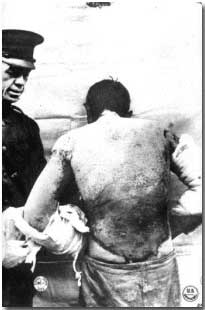 The
first German use of artillery fired chemical shells occurred at
Neuve-Chapelle on 27 October 1914. In this battle, Germany modified
the 105-mm shells so that shrapnel surrounded a lachrymator.
The
first German use of artillery fired chemical shells occurred at
Neuve-Chapelle on 27 October 1914. In this battle, Germany modified
the 105-mm shells so that shrapnel surrounded a lachrymator.
The Allies did not detect the firing chemical shells since the dispersal of the chemical was small and the irritating action so benign. Because the chemicals were not asphyxiators or deleterious gases, and the chemicals were surrounded by a shell designed to send shrapnel through the air, Germany did not believe that these shells violated the Hague Conventions.
Germany soon increased their development of gas shells but they had trouble with filling the shells. Initially, Germany had only one toxic gas, diphosgene, which was not an all-round chemical agent. Since flexibility and specificity was the essence of artillery warfare, the Germans were hampered until they discovered mustard gas and other arsenic compounds in mid-1917.
By the time Germany stopped using gas clouds, they had a variety of shells filled with various agents at their disposal. However, convincing the artillerymen of the usefulness of chemical shells was not easy. Firing chemical shells had no precedent and a lot of learning by experience was done by artillerymen who normally had a conservative attitude to war. "The first known German gas-shell instructions are dated 6 August 1915," and applied to tear-gases. It was not until mid-February 1917 that German leaders felt that they had learned enough about the use of chemical filled artillery shells to produce new instructions concerning their tactical use. However, by the end of the war, half of Germany's basic artillery load was chemical shells.
Germany, enjoying the lead in the development of chemical agents and chemical shells, was able to experiment with different types of chemical shells and different amounts of explosive. They learned that by increasing the amount of explosive in a mustard gas shell, that the area contaminated was larger. They also discovered that when a smaller amount of explosive was used, that the agent persisted longer. By further experimentation, Germany was able to develop shells that could spread out the chemicals to a maximum radius while keeping them airborne the longest. From this knowledge, the Germans began making gas barriers and gas pockets.
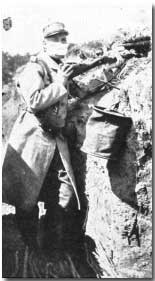 Germany
believed in using surprise and high concentrations of gas against the
Allies. They also fired both chemical and high explosive shells during
an attack so that the result was even more deadly than either of the attacks
by themselves. Persistent agents often served as gas barriers in both
the offence and the defence.
Germany
believed in using surprise and high concentrations of gas against the
Allies. They also fired both chemical and high explosive shells during
an attack so that the result was even more deadly than either of the attacks
by themselves. Persistent agents often served as gas barriers in both
the offence and the defence.
Although Germany wanted to surprise the Allies when they used a non-persistent gas so that it caused a lot of casualties, this was not necessary for persistent agents. When using persistent agents, artillery fire would last for several hours and thoroughly contaminate an area.
Germany could renew the contamination by firing more shells into the target area each day. They also discovered that by using a variety of agents in a battle that they effected the ability of the masks to filter out the poisons.
Along with normal gas-filled shells, the Germans used "projectors." A British Captain, William H. Livens, created the first projectors. The projectors were similar to a trench mortar except that they fired large gas-filled shells. The British first used this delivery system at Arras on 4 April 1917. German reports state that the density of the projector shots matched that of a gas cloud. Soon after the Arras attack, Germany developed and used its own "projectors" against the Allies. One of the most important aspects of the projector attacks was that they dispersed a very dense concentration of gas that usually came as a surprise to the enemy, unlike the already discarded gas clouds that were seen moving across the battlefield.
Protection Against Chemicals
One of the most indispensable items for the Allied soldier was his gas mask. As the war progressed, the various types of gas that Germany used forced the Allies to be adaptable. Since the mask was designed to protect the soldiers from specific chemicals, the use of a new chemical forced the soldier to unmask because the filter either became clogged or unable to filter out the new agent. Once a soldier unmasked, he was susceptible to secondary chemical attacks. Whenever Germany used a new chemical on the battlefield, the Allies had to design new filters with different agents in them to counteract the new poison. Unfortunately for the Allies, this sometimes took several months, and in the meantime, the soldier was somewhat defenceless against the new chemical agent. Besides filtering out poison gas, the gas mask also had to be comfortable and allow for full vision and easy breathing. It also had to be durable and allow soldiers to communicate with each other.
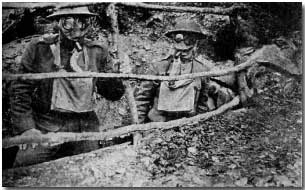 Initially,
the use of chlorine at Ypres caught the Allies unprepared, but they quickly
improvised and made masks to protect the soldiers.
Initially,
the use of chlorine at Ypres caught the Allies unprepared, but they quickly
improvised and made masks to protect the soldiers.
As the war progressed, the Allies, although unable to agree on a common mask, were able to experiment with different types of masks until they found the best masks for their troops. Chemical defence is the one area that Germany fell behind the Allies.
This was primarily due to two reasons. First, the Allies were always behind on the creation of new gases so they were constantly working on new and better masks to counteract the German advantage in creating and using poison gases. Secondly, as the war progressed, the Allies were less limited in natural resources than the Germans were and Germany found itself forced to use substandard materials in their masks.
Medical Treatment
Proper medical treatment was extremely important because the use of gas had a debilitating effect on soldiers. Not only did poison gas physically injure soldiers, it also added a psychological element that common artillery could not match. Soldiers felt that they could hide in their trenches and comfort each other when under a conventional artillery attack, but that they were by themselves and had no real defence other than a mask when under a gas attack. This contributed to depression and war weariness. Some doctors were not sympathetic to those suffering from gas poisoning and the battle fatigue it caused and blamed the soldiers for malingering. Unfortunately, few doctors knew how to deal with the medical problems associated with gas poisoning at the beginning of the war. In many cases, there was no remedy. The men simply had to be put on bed rest and hope for the best.
As the war progressed, doctors became more adept at recognizing the effects of certain chemical agents and were better able to treat them. However, due to the lack of anti-toxins, bed rest remained the most common form of treatment. In many of the cases involving lachrymators as their exposure to the agent had been minimal. The soldiers that were exposed to large doses of the lachrymators often died. Soldiers who inhaled asphyxiating gases usually died. Mustard gas was probably the most difficult gas that the medical facilities had to deal with. Not only did it temporarily blind the individual, but it also produced blisters on exposed skin. Mustard gas thus caused a large number of casualties that required extensive medical treatment. As the number of soldiers wounded by gas increased, field hospitals became over-burdened with them. Eventually, some special hospitals were set up that dealt solely with soldiers suffering from chemical related injuries.
The next section will discuss the use of chemical agents in several battles. It will discuss operations in which Germany used chemical agents, the effects on the enemy (and sometimes friendly troops), and the lessons learned by the Germans.
Chemical Use at Ypres
Ypres is the most famous of the chemical attacks, primarily because it was the first gas cloud attack. The German High Command chose Ypres not because it was the best place to use gas, but because the other German commanders refused to use gas in their theatres. Ypres was not a good location for gas cloud usage. The terrain is not even and the slight differences in terrain of 5 - 10 meters caused the gas cloud to move in unpredictable ways. The wind, which dominates the use of gas clouds, was generally from the west. This meant that the Germans had to ensure that when they released the chlorine, that a wind from the east would blow the gas towards the enemy. This reliance on the wind meant that planning for an exact day and time was very difficult and therefore coordination with an infantry assault was extremely complicated. The infantry that was to follow the gas cloud initially did not have any type of protection. However, prior to the attack, the soldiers were issued mouth pads.
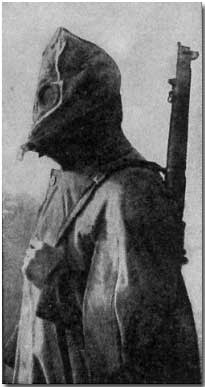 Finally,
after several false alerts, Germany released approximately 150-168 tons of
chlorine against the Allied forces along a 7-kilometer front on the evening
of 22 April 1915. The gas engulfed the Franco-Algerian soldiers that
manned the front lines. Many of these troops ran away, and hundreds
lay dying in the 7 kilometre wide opening that the gas caused.
Finally,
after several false alerts, Germany released approximately 150-168 tons of
chlorine against the Allied forces along a 7-kilometer front on the evening
of 22 April 1915. The gas engulfed the Franco-Algerian soldiers that
manned the front lines. Many of these troops ran away, and hundreds
lay dying in the 7 kilometre wide opening that the gas caused.
The German soldiers slowly advanced into the breech created by the gas cloud. Canadian and British troops on the flanks of the gas cloud quickly organized a defensive line approximately 7 kilometres behind the initial front lines and stopped the Germans from advancing any further.
The German troops reached their initial objective, but the wear of waiting approximately a month for favourable winds, and the sight of the destruction that the gas cloud caused, limited them from advancing any further. If the Germans would have had a large force in reserve, their advance could have caused a break through, cutting the Allied defences in half. However, the Germans were not expecting such success from the new weapon and were unprepared to take advantage of the situation.
Chemical Use in Russia
On 31 May 1915, Germany discharged 220 tons of phosgene along a 12-kilometer width against Russian troops in vicinity of Bzura and Rawka. The German soldiers in this sector had no previous experience with chemical warfare and received no information about the chemical weapon, except that it would kill the Russian troops in front of the advancing Germans. When the gas cylinders opened, a cloud of gas floated across the battlefield towards the Russians. The Germans advanced directly behind the gas cloud. A few scattered shots hit some of the advancing Germans and the rest of the German force decided that the gas attack had failed and fell back to their trenches. In reality, the gas had stripped the Russian front of most of its defenders. The Germans mounted a second gas attack on 12 June 1915. Unfortunately, the wind changed direction after the release of the gas and blew it back towards the German troops.
The Germans, who had no gas masks, panicked at first. However, the wind changed direction again and the Germans advanced 6 kilometres. On 6 July 1915, gas was used again. The Russians, becoming used to chemical attacks, held their frontal positions lightly and did not suffer many casualties. Once again, the wind shifted and the gas blew along the German front lines. The three German attacks had cost the Russians an unknown number of casualties, but more importantly, it had caused the Germans over 3,000 casualties. The lesson learned by the Germans was that a gas cloud was totally dependent on the winds, strength and direction. Since meteorological art was still relatively new, neither could be predicted with any amount of accuracy. It also showed that a synchronization of gas discharge with an infantry attack was extremely dangerous. The result, although not immediately recognized, was that the gas cloud would be better used as a psychological weapon that would demoralize the enemy than as a primary weapon.
Chemical Use at Verdun
When Germany attacked Verdun on 21 February 1916, they planned a massive, sustained attack. The German General Staff believed that France would use every man possible to hold the historic citadel and that the attack would actually turn into successful battle of attrition. Germany opened the attack by conducting a nine-hour artillery bombardment using approximately 850 heavy guns. Germany fired both conventional and chemical shells at the French defences. France retaliated with phosgene shells on 22 February. As Germany predicted, France rotated division after division into the Verdun area to halt the German attack.
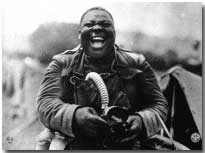 On
19 May, Germany used a liquid gas shell at Chattancourt that caused many
casualties, however, France's defence continued to hold. On 22-23
June, Germany launched its' last major attack on Verdun. German
artillery fired over 110,000 chemical shells filled with phosgene. The
concentration was so high that the French masks were unable to filter out
the agent, and the French artillery crews, the principle targets, fell
silent. "Men and horses were caught and killed by the terrible fumes.
Doctors treating the wounded were themselves struck down."
On
19 May, Germany used a liquid gas shell at Chattancourt that caused many
casualties, however, France's defence continued to hold. On 22-23
June, Germany launched its' last major attack on Verdun. German
artillery fired over 110,000 chemical shells filled with phosgene. The
concentration was so high that the French masks were unable to filter out
the agent, and the French artillery crews, the principle targets, fell
silent. "Men and horses were caught and killed by the terrible fumes.
Doctors treating the wounded were themselves struck down."
German soldiers advanced and seized the first objective, but could not exploit their success due to a lack of reserves. On 9-10 July, Germany fired 63,000 chemical shells at the Souville defence. Here, however, France had issued its artillerymen the more advanced M2 mask and the soldiers were not incapacitated and they continued to fire their guns and halted the German advance. This was the last major German attack on Verdun. Germany had to end the attack after the British attacked Somme, which caused the Germans to reinforce that area.
During the Verdun offensive, the Germans fired a variety of chemical shells at the French, who retaliated by firing chemical rounds back at the Germans. In one battle, German artillery fired 2,000 tear gas shells at the French defenders in a surprise bombardment. This attack temporarily blinded the French soldiers while the German soldiers, wearing goggles but no masks, advanced and captured about 2,400 Frenchmen. Although the use of gas during the Verdun campaign did not significantly alter the battle, it did cause a significant number of French casualties that caused further logistical and medical difficulties on a French system that was already over-burdened with conventional injuries.
Effectiveness of Chemical Warfare
A number of historians have published widely differing estimates on the number of casualties and deaths that German gas usage caused during the war. The numbers for casualties range between 300,000 and 900,000. The number of deaths as compared to casualties varied between countries. Russia probably had the highest death ratio, while the US had the lowest ratio. It is also important that the highest death ratio occurred early in the war, but as the war progressed and defensive measures improved, the ratio decreased.
 The
problem associated with having an exact count of causalities was due to
several factors. Initially gas casualties were listed as 'other
causes' and therefore the exact number of men who were casualties in the
early phase of gas usage is relatively unknown. Soldiers also said
they had been gassed as an excuse to get a respite from the front-line.
Although doctors would eventually determine if soldiers were actually
suffering from gas, these men were often recorded in their units' record as
being exposed to gas. Thus an exact number of men who were gas
casualties and those who were faking it is impossible to determine.
The
problem associated with having an exact count of causalities was due to
several factors. Initially gas casualties were listed as 'other
causes' and therefore the exact number of men who were casualties in the
early phase of gas usage is relatively unknown. Soldiers also said
they had been gassed as an excuse to get a respite from the front-line.
Although doctors would eventually determine if soldiers were actually
suffering from gas, these men were often recorded in their units' record as
being exposed to gas. Thus an exact number of men who were gas
casualties and those who were faking it is impossible to determine.
A third problem is the lack of accurate record keeping by various countries themselves, or the fact that some countries did not release the number of soldiers who suffered from gas poisoning. Russia is a prime example of this.
Was gas a force multiplier? General John J. Pershing stated "that gas was a significant weapon, but not as a producer of battle deaths." Gas in World War I was an effective weapon because it made combat more difficult. Wearing chemical masks made the firing of weapons difficult. The wearing of masks also hampered the communication system. Chemical warfare also clogged down the Allied logistical system with chemical defence-related equipment instead of offensive equipment. Gas also had a psychological effect on the soldier. The purpose of many of the attacks was to "surprise, shock, and worry the opponent."
Gas attacks often occurred at irregular intervals in the quiet sectors of the front. These attacks were especially successful as the soldiers who had been sent to these quiet areas to rest, instead found themselves tense and on the alert much of the time. The use of gas barriers and gas pockets to limit the advance of troops through certain areas and channelise them into kill zones also changed the battlefield. The use of gas also caused chemical units to come into existence and these units took men away from the combat arms.
However, gas clouds and projector operations were too unreliable to contribute significantly to battlefield success. In the two years after Ypres, gas was more of a psychological weapon that wore down the enemy than a killer of men. In this context, the use of gas could produce temporary and local demoralization. However, in the larger scheme of things, it could not win the war by itself. The use of gas filled artillery shells did produce some favourable results in the last year and a half of the war, but it still did not cause as many casualties as conventional weapons.
The extension of chemical warfare to the combat arms was a slow process. The officers generally did not want to experiment with new weapons. Once the artillerymen began to use chemical shells, their use on the battlefield was generally accepted as just another hazard that the defenders had to face.
Conclusion
Initially, Germany held the lead in chemical agent deployment. From 1915 to 1918, the tactical employment of chemical weapons varied between the belligerents. However, by late 1918, both sides were using similar delivery systems and chemical agents. The effect of gas should be neither belittled nor exaggerated. The numbers of gas casualties were often inflated or decreased, depending on the needs of the moment for propaganda reasons. "The novelty of the weapon, the secretiveness of the chemists, and the inexperience of the troops provided ideal conditions for the growth of legends, for claims and counter-claims, and for assertions that went unchallenged." After the signing of the armistice, the use of chemical agents during World War I caused the public and the military to closely examine them, and prepare for their future use.
Article contributed by
Brian Blodgett, Professor, American Military University.
Photographs courtesy of
Photos of the Great War website.
A "conchie" was slang used to refer to a conscientious objector.
- Did you know?
